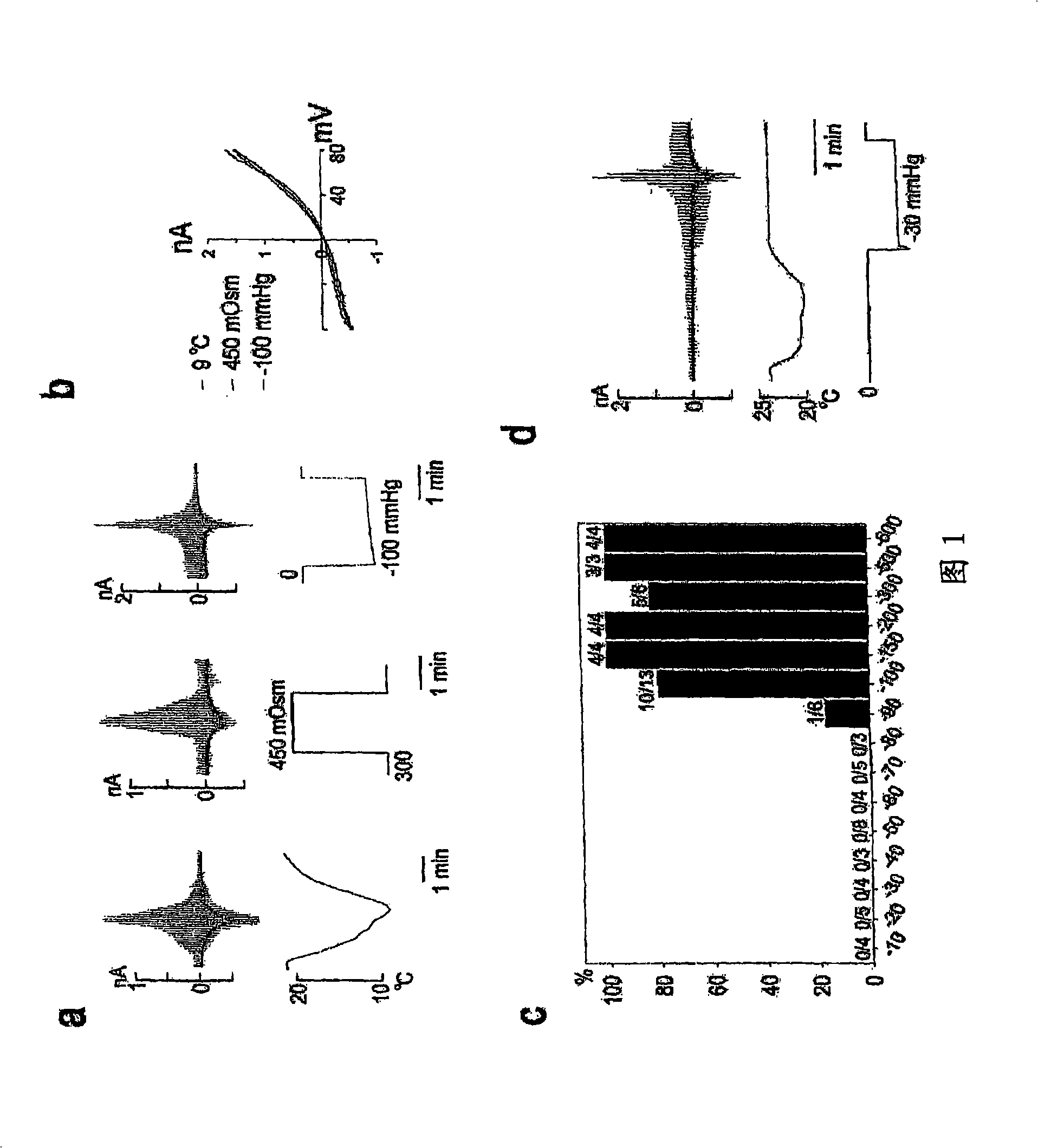Methods and compositions for treating hyperalgesia
A technology for hyperalgesia and compounds, which can be used in drug combinations, pharmaceutical formulations, non-central analgesics, etc., and can solve problems such as unknown molecular identities
- Summary
- Abstract
- Description
- Claims
- Application Information
AI Technical Summary
Problems solved by technology
Method used
Image
Examples
Embodiment 1
[0059] Example 1. TRPA1 is a polymorphic receptor for nociceptive mechanical and thermal stimuli
[0060] We tested whether TRPA1 is activated by mechanical force. The electrophysiological behavior of Chinese hamster ovary (CHO) cells expressing thermoTRP was studied in two different mechanical stress-stress application assays using recording pipettes and varying external osmolarity. In whole-cell recordings, TRPA1-expressing cells induced cell contraction [either -100 mmHg suction (n = 10) or application of 450 mOsm hypertonic solution (n = 8)] (Fig. 1A) but not cell swelling [or by Stimulation of +100 mmHg (n=11) or 220 mOsm (n=8)] showed robust current responses. Currents evoked by pressure, hyperosmosis, or cold (n = 62) showed similar desensitization and had similar reversal potentials and rectification properties, suggesting that these mechanosensitive currents result from TRPA1 activation (Fig. 1B). It was also observed that non-transfected control CHO cells and oth...
Embodiment 2
[0063] Example 2. TRPA1 plays an essential role in mechanical pain perception in vivo
[0064] We next tested whether acute blockade of TRPA1 had any physiological consequences on pain perception. RR, Gd 3+ Or camphor is not a specific compound and cannot be used in vivo. Using the FLIPR calcium influx assay, we screened 43,648 small molecules for their ability to block cinnamaldehyde-activation of human TRPA1 in CHO cell lines. Several hits were shown to be structural analogs of cinnamaldehyde. We performed an in-depth analysis of one of these analogues, compound 18, (Z)-4-(4-chlorophenyl)-3-methylbut-3-ene-2-oxime (Maybridge, Cornwall, UK). Compound 18 blocked TRPA1 activation by 50 μM cinnamaldehyde in the CHO cell FLIPR assay, and its IC on human and mouse clones 50 The values were 3.1 μM and 4.5 μM, respectively ( FIG. 3B ). In contrast, compound 18 did not block TRPV1, TRPV3, TRPV4 and TRPM8 at 50 μΜ (data not shown). Compound 18 reduced the EC of cinnamaldehyd...
Embodiment 3
[0066] Example 3. Further evidence for the function of TRPA1 in mechanical and cold hyperalgesia
[0067]To the best of our knowledge, it is not possible to test the noxious cold response in mice. For example, mice show no nociceptive response to hypothermia as low as 0 °C and no cold allodynia in response to CFA. Cold activation of TRPA1 is controversial, but its in vivo role in cold hyperalgesia in rats has recently been proposed (Jordt et al., Nature 427:260, 2004 and Obata et al., J Clin Invest 115:2393, 2005). We therefore explored the role of TRPA1 using compound 18 in rats. We found that rat TRPA1 was also blocked by compound 18, similarly to human and mouse TRPA1 (data not shown). We observed that CFA-induced cold hyperalgesia in rats was potently blocked by Compound 18 in a 5°C dish (Fig. 4C). Taken together, these data suggest that TRPA1 functions as both a cold sensor and a mechanoreceptor in vivo, but only after sensitization with inflammatory or injury signal...
PUM
 Login to View More
Login to View More Abstract
Description
Claims
Application Information
 Login to View More
Login to View More - R&D
- Intellectual Property
- Life Sciences
- Materials
- Tech Scout
- Unparalleled Data Quality
- Higher Quality Content
- 60% Fewer Hallucinations
Browse by: Latest US Patents, China's latest patents, Technical Efficacy Thesaurus, Application Domain, Technology Topic, Popular Technical Reports.
© 2025 PatSnap. All rights reserved.Legal|Privacy policy|Modern Slavery Act Transparency Statement|Sitemap|About US| Contact US: help@patsnap.com



